Solanum melongena, popularly known as the eggplant, aubergine, or brinjal, is a purple warm-season plant. It is advisable to grow it in the warmest and frost-free season.
Eggplant is delicious in soups or simply eaten as a side. Most users roast it, puree, bake, fry, or saute depending on personal preferences. Since it has no strong flavor, it is easy to pair with other meals. It is used in many dishes, especially for vegetarian and vegan recipes.
Learning how to grow your eggplant in the garden can be a plus. It is pretty easy as long as you get the basics right.
Basics About the Eggplant
The eggplant is native to Asia, where it grows in the wild as a perennial in the warm season. However, American gardeners treat it as an annual. Due to its tropical and subtropical regions, the eggplant is closely related to tomatoes and peppers, which do well in warm climates.
Eggplants are in the nightshade family and depend on high temperatures to thrive. This explains why they tend to be very slow growing in cold weather. The plants grow from a small to medium bush. They produce smooth glossy fruits at optimal growth levels, which are the edible parts. The fruits range from purple, yellow, creamy-white, brown, or almost black.
The fruits have varying lengths and can be long and slender. Some are round and egg-shaped and often range between 5-12 inches. The eggplant has large and fuzzy gray-looking leaves. The flowers are star-shaped and lavender in color with yellow mid-centers. In most cases, eggplants grow 2-6 feet tall. It all depends on the eggplant variety.
Growing Eggplants
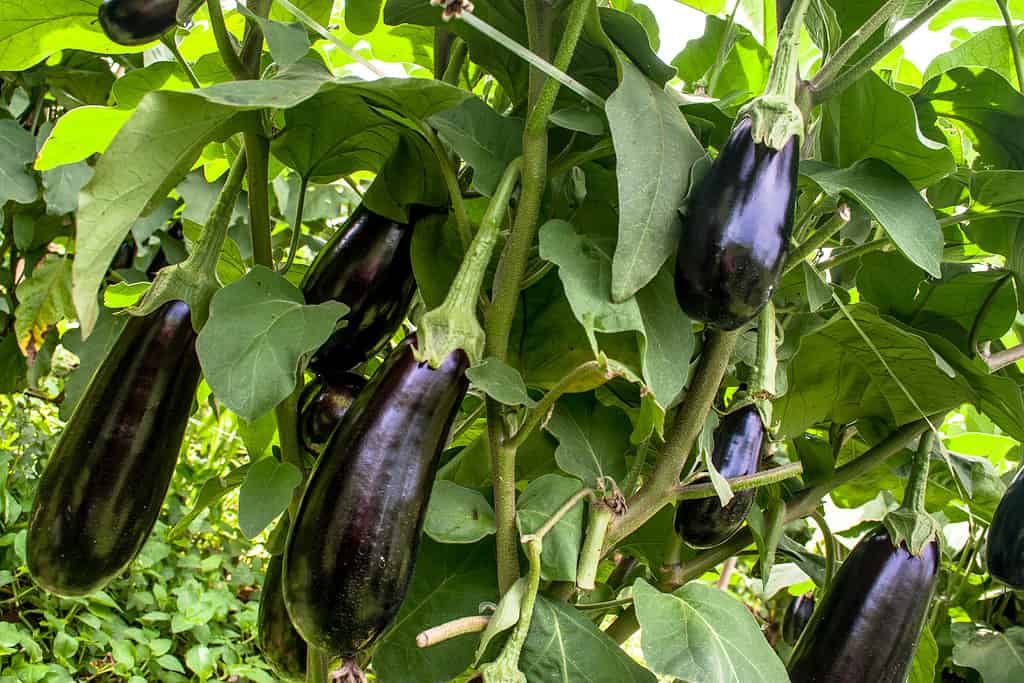
Eggplants are in the nightshade family and depend on high temperatures to thrive.
©Alf Ribeiro/Shutterstock.com
Eggplants are not complex to grow. It is recommended to start your eggplant growing journey indoors from seeds. Grow the seeds for up to 8 weeks before transplanting the seedlings to the main garden outdoors.
- Sow the seeds in individual flats or containers. The seeds should be sown at least 12mm deep. This is ½-¼ deep. Space the seeds 10-12 cm apart or 4-5 inches apart.
- Sow the seeds in a moist seed-starting mixture. Use a plastic dome or wrap to cover/ mulch the seed planting tray. This helps retain the moisture and warmth until the seedlings emerge.
- Germination happens after 5-6 days.
- Use a grow light to supply at least 12 hours of daily light exposure for the indoor seedlings. Fluorescent lights also work great.
- Start the seeds on a heat mat and switch to growing the seedlings at 21°C/ 70°F.
- Prepare to transfer the seedling to 4 inches/ 10 cm tall pots when the seedlings reach 3-4 inches or 7-10 cm.
- When the seedlings reach 5-6 inches tall/ 12-15 cm tall, transplant them to the field or gallon containers if the weather does not allow field transplanting.
- At this stage, expose the plants to 10 hours of light daily. Make sure to turn the plants every other day for proper growth. This ensures the plants grow strong and straight.
- Before transplanting, lay plastic across the beds you will be transplanting to. This prewarms the soil and makes it ready for transplanting.
- Alternatively, avoid the hustle of growing your eggplants from the seeds by purchasing seedlings at 6-8 weeks old. Find a garden center you can trust near you and buy from them.
Planting Eggplants – Everything you Need to Know
It’s ideal to plant your eggplants in areas that receive a maximum of 6-8 sunlight hours daily. Note that the soils should be well drained and loamy if you want excellent results.
Choose grounds that have fair to high levels of organic matter. Make sure to supply enough water and warmth to promote optimal growth.
Ideal Soils for Growing Eggplants-Where to Grow Eggplants Successfully

For eggplants, choose a soil with fair to high levels of organic matter.
©Africa Studio/Shutterstock.com
Eggplants need well-drained, fertile soils to thrive. Go for loamy soils/sandy-loam soils with rich organic components. You can enrich the soils by mixing an inch of properly rotted manure, fertilizer, or compost manure.
Consider getting a commercially available planting mix if you cannot access aged manure. Add this to the planting beds before planting. Mix it 12 inches deep into the soil.
You can also mix rotted manure, compost, and general fertilizer into the soil in a 5-10-5 ratio. Add this on the planting beds at least one week before transplanting your eggplant. Apply 2-3 pounds on 100 square feet of land.
Alternatively, apply 1¼ pounds of the mix to every 10 feet row, especially when you have 4 feet of spacing between rows. Besides getting the proper soil fertility, make sure to keep the pH at 5.8-6.5 for optimal growth of the eggplants.
When and How to Transplant your Eggplant Seedlings
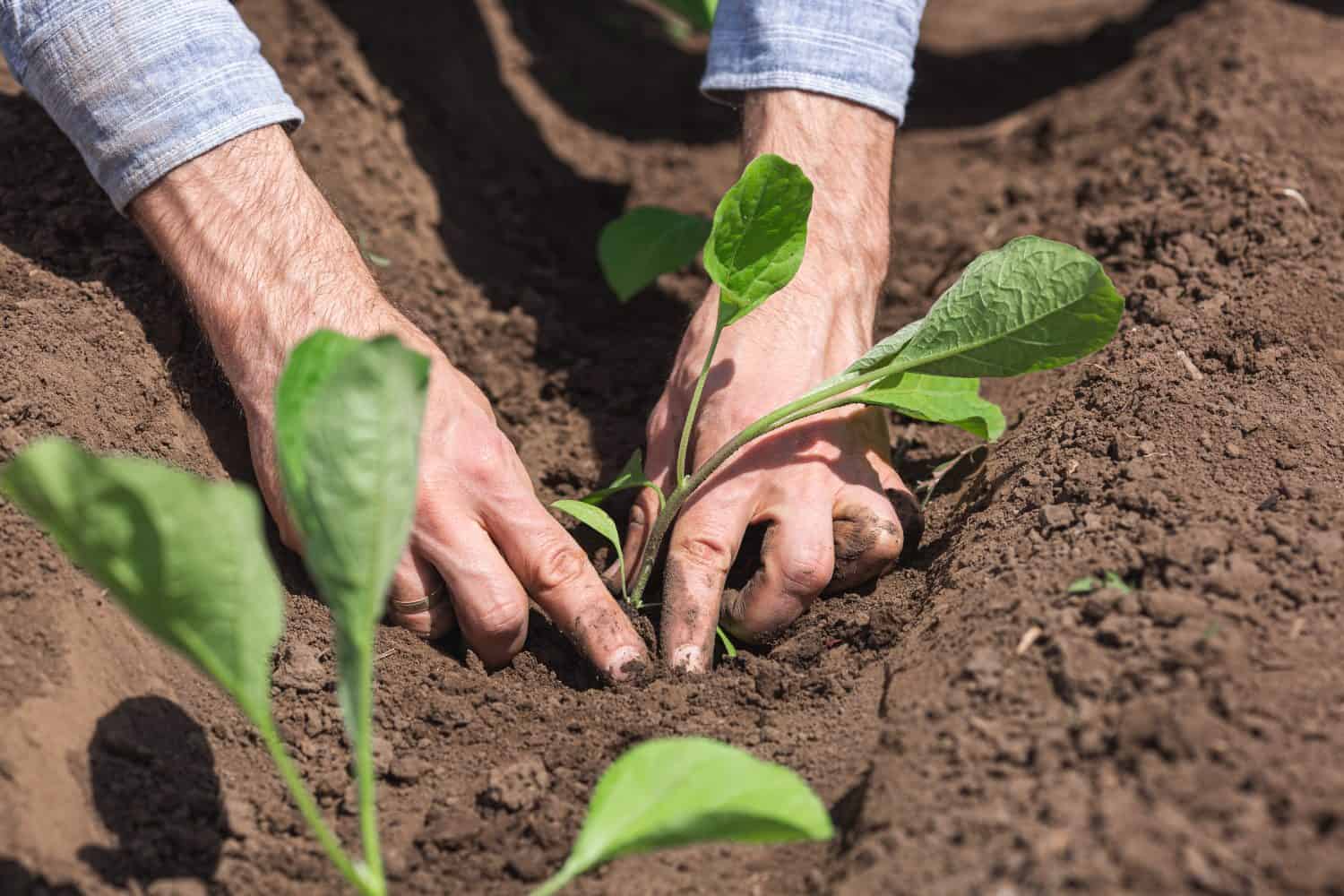
Plant eggplant seedlings 2-3 weeks after last frost.
Image: Marina Varnava, Shutterstock
©Marina Varnava/Shutterstock.com
- Only transplant your eggplant seedling to the beds outdoors after 2-3 weeks of the last frost fall. You may need to warm the soils in readiness for the young plants. This will ensure they get proper establishment.
- Make sure to harden the seedlings right before transplanting. Start by exposing them to harsh sunlight for over an hour on day one. Increase the exposure time until when the seedling becomes acclimatized to extreme conditions.
- Once hardened, create planting holes twice the width of the plant’s root ball. Make sure the hole is half as deep. You should also put some water in the hole to finally transplant the seedlings.
- Sprinkle the 5-10-5 or at the hole’s bottom and proceed to cover it lightly with some aged compost fertilizer. You can also use commercial organic fertilizer. Only then should you place your seedling in its rightful place.
- You should set the seedlings in your garden, ensuring the depth is similar to when growing them in containers.
- Ensure the soil is firm around the seedling’s root, and gently water it. It would be best to make a tiny basin around eggplant seedlings to ensure direct watering of the roots during the watering time.
- You should then set up a small cage to help support the eggplant when growing. Note that your eggplant, like tomatoes, will be loaded with fruits when it matures. Loaded eggplants easily tip over and fall without adequate support.
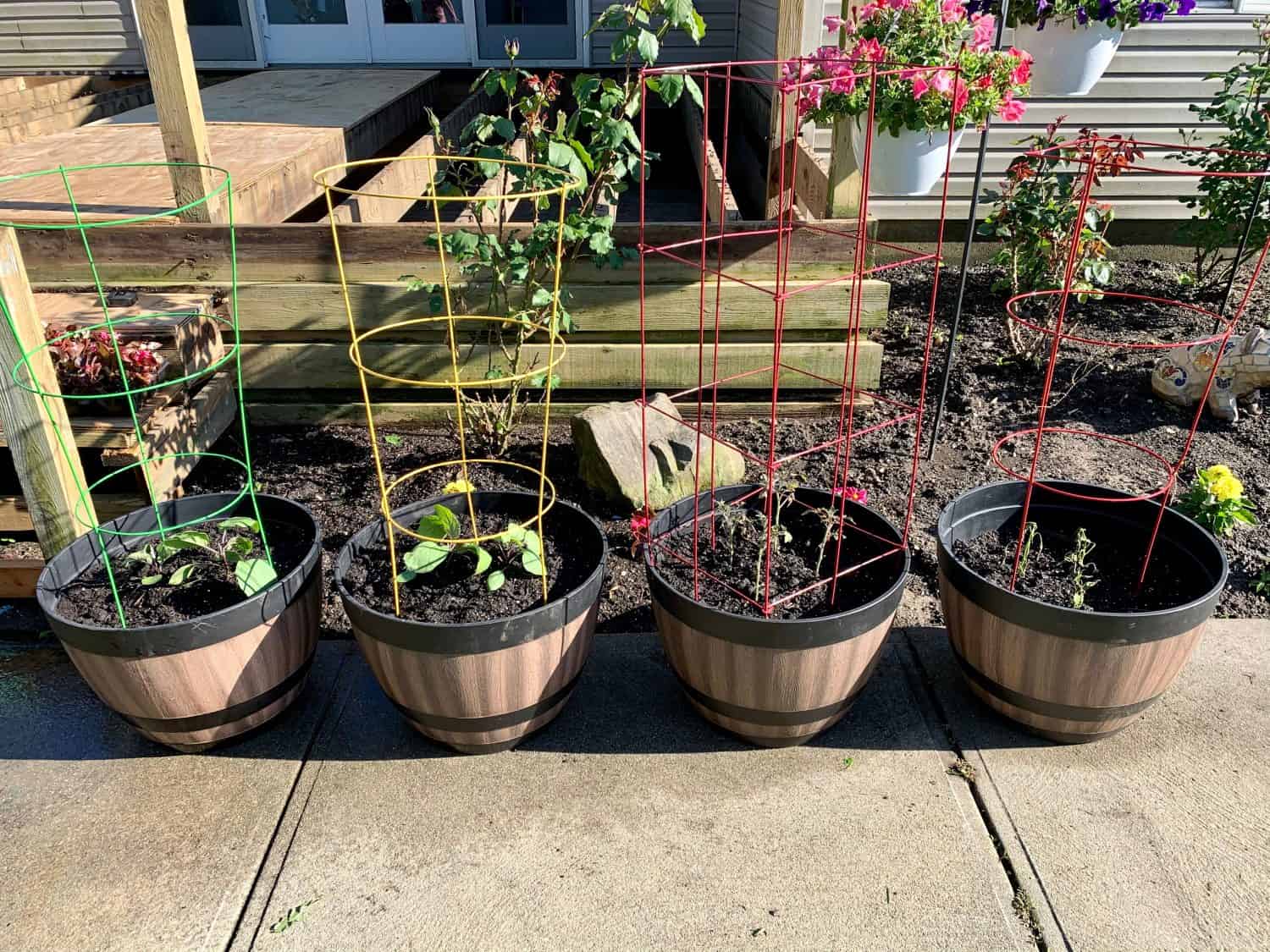
Eggplant should be supported by a cage.
Image: Jaclyn Vernace, Shutterstock
©Jaclyn Vernace/Shutterstock.com
How to Space Eggplants
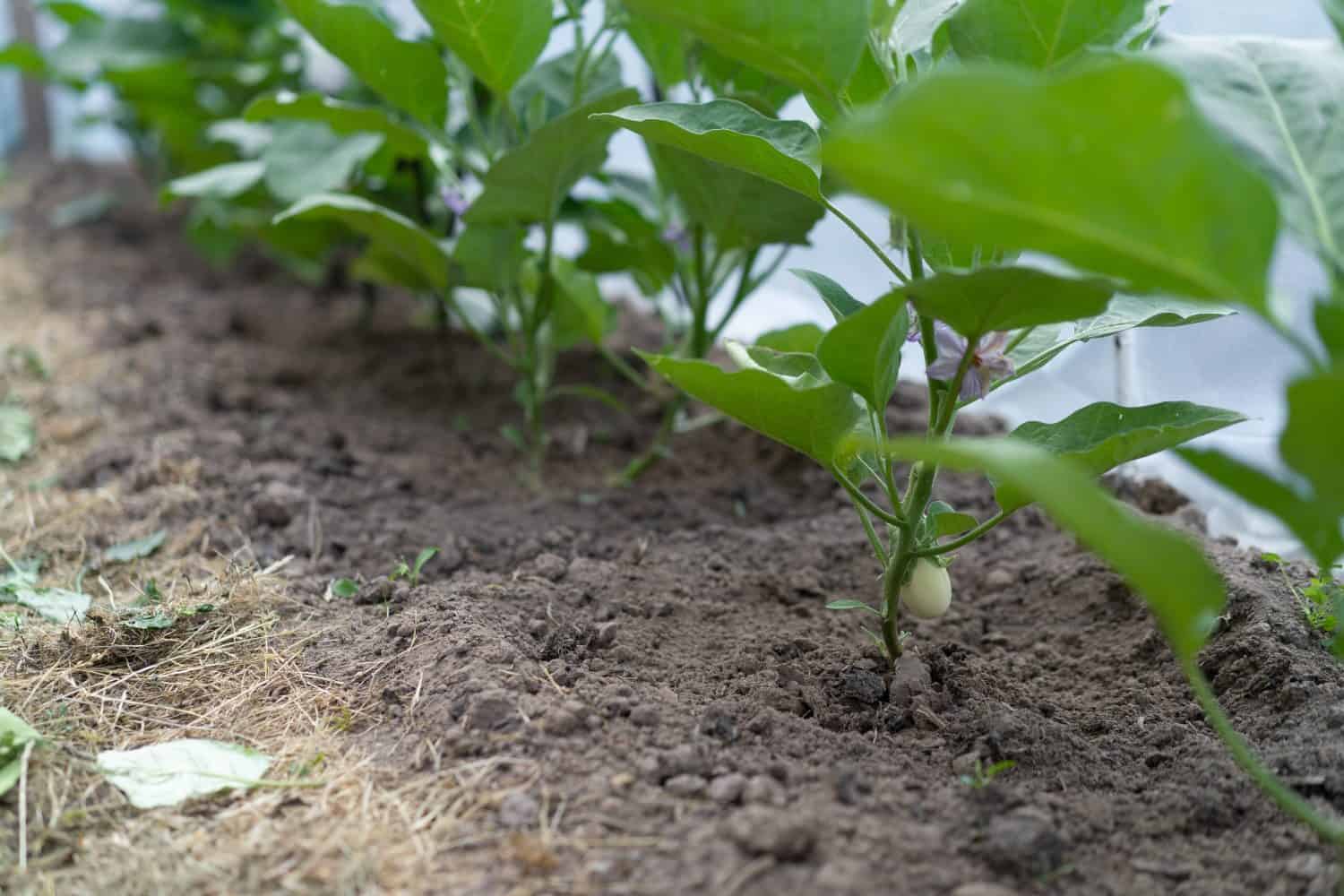
Image: KIRAYONAK YULIYA, Shutterstock
©KIRAYONAK YULIYA/Shutterstock.com
Be sure not to overcrowd eggplants. The recommended spacing should be 24-36 inches/61-91 cm. This translates to a spacing of approximately 2 square feet apart for each plant. Note that the specific spacing instruction depends on the eggplant variety hence the need to check the instructions. Spacing between rows should be 24-36 inches.
Spacing is key as it promotes adequate growth due to proper air circulation needed to support proper fruit ripening. Proper spacing also promotes better disease and pest control as it curbs spread.
Cover the younger eggplants using a polythene cover in each row. This ensures that the plants are warm during colder months. You can lift these covers on warmer days to allow bees in for pollination.
Growing Eggplants in Containers
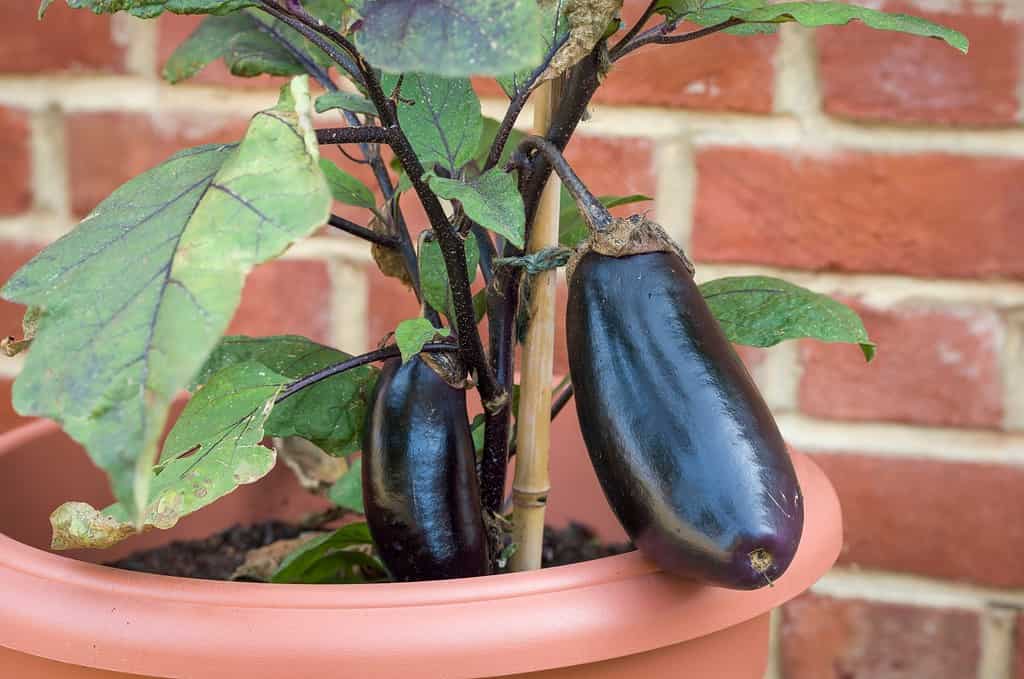
Stressful watering will lead to bitter eggplant fruits. Stay consistent with watering if you want to improve and guarantee quality fruits when harvesting.
©Paul Maguire/Shutterstock.com
It is not always possible to grow eggplants out in the field. Fortunately, you can quickly grow them in containers. Choose pots that are 12 inches/ 30cm wide. Go for a smaller variety if you increase your eggplant in a container.
Make sure the soil in the pot is always moist. Never allow the soil to dry out at any given point.
Work on feeding the potted plants every 2-3 weeks. Add a diluted fish emulsion solution or compost tea. This will replenish the nutrients the plant needs to thrive.
Move the containers indoors if the weather threatens to frost.
How to Water your Eggplants
Eggplants grow fast and well when they are in moist soils. Don’t let the soils dry out; avoid overwatering them. Once you have transplanted the seedlings, use a drip system or soaker hose pipe. Ensure each plant receives water measuring at least an inch every week.
Be consistent when watering the plants. Note that varying the moisture content in the soil often results in fruit mishaps. Once the soils attain a temperature of 21°C and have good moisture content, mulch around the eggplant to guarantee moisture retention.
The timings also matter when watering plants. Make sure to prioritize early mornings, especially on hot days. Resist overhead irrigation, as this often leads to fungal infection.
Keep checking on the soil daily or every other day in the summer. This is the best way to monitor and ensure the soil never dries. It will also direct when to water the plants since you must put an index finger in the soil to confirm. Water the eggplants if the fingers come out dry.
Stressful watering will lead to bitter eggplant fruits. Stay consistent with watering if you want to improve and guarantee quality fruits when harvesting.
Eggplant Feeding
This is one of the heavy-feeding vegetable varieties around. Besides the well-rotted organic manure, you added at the beginning of the transplanting phase, keep feeding the plants.
Sidedress with fish emulsion or compost tea regularly. Do this 2-3 weeks before the fruit sets and 3-4 weeks once the fruits form.
Common Eggplant Companion Crops
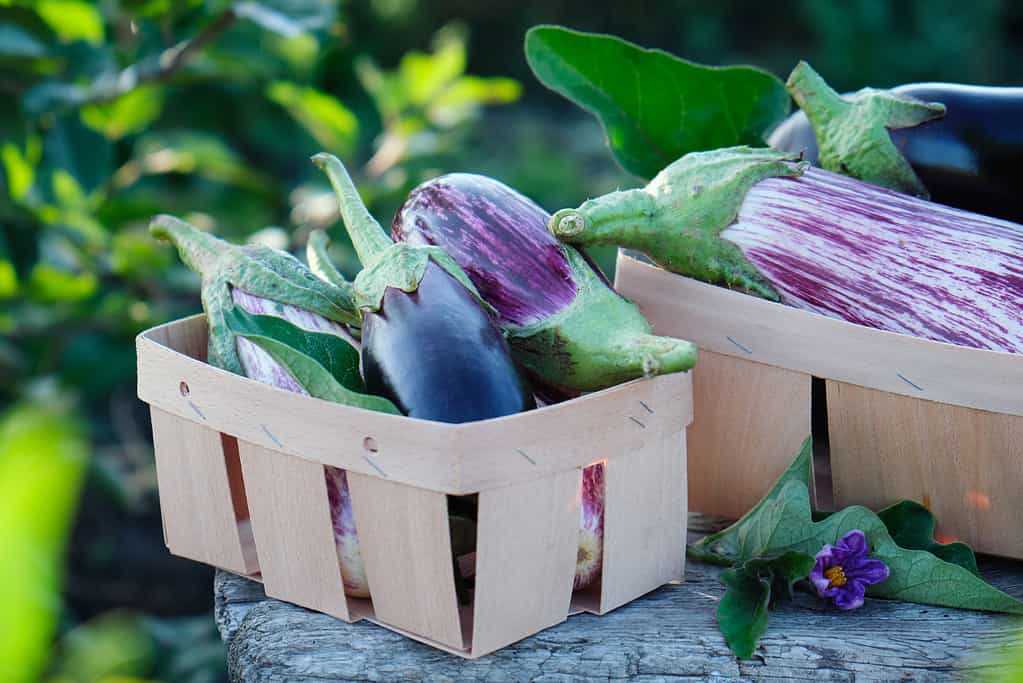
Never plant eggplants with crops of the same family, such as corn or tomatoes, as they use the same nutrients and will likely compete.
©Valentina_G/Shutterstock.com
Companion plants refer to plants that can be grown together with the crop in question. These plants would supplement nutrients without depleting specific nutrients for each other. Eggplants thrive with southern peas, beans, and other nitrogen-fixing crops.
Never plant eggplants with crops of the same family, such as corn or tomatoes, as they use the same nutrients and will likely compete.
How to Care for Eggplants
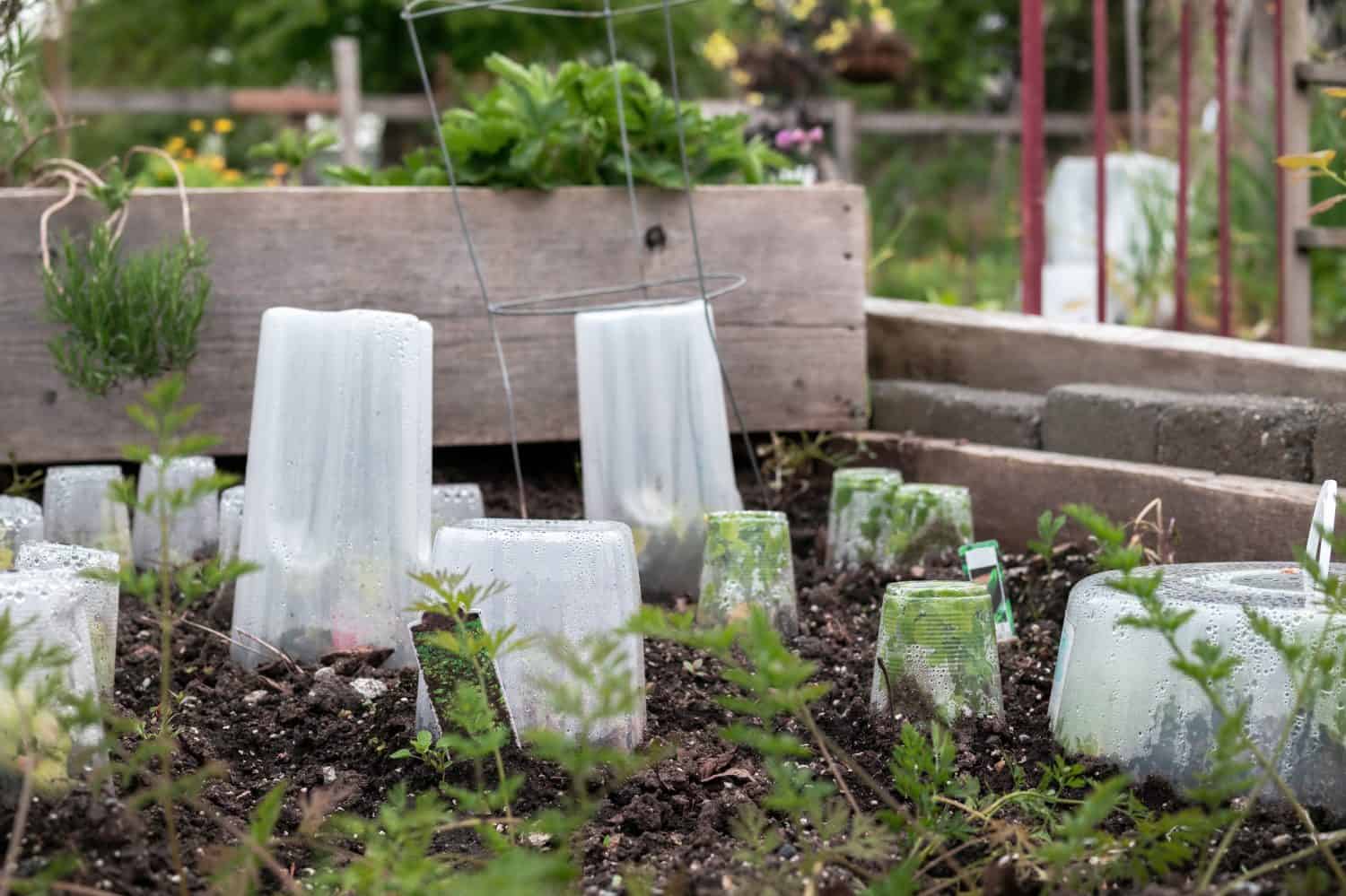
Protect your eggplant from frost with protective coverings.
Image: sophiecat, Shutterstock
©sophiecat/Shutterstock.com
The success of your eggplant depends on how well you care for it. There are a few things you need to know about eggplant.
- Protect the plants against frost at night and on cold days. Use a polythene cover. Note that chilly weather conditions will inhibit pollination and affect moisture retention.
- Make sure to care for the plant’s roots during hot weather. Mulch the plants to prevent too much warmth. Make sure to use aged mulch.
- Use shades in areas where the temperatures get too high. This applies to areas where temperatures get to 37°C/100°F.
- Stack or cage tall eggplant varieties.
Pest and Disease Prevention
Eggplants are not immune to pests and diseases, just like other plants. Unfortunately, they are attacked by common pests, including:
- Cutworms – Eat the young eggplants just above the moist soil surface. Putting collars on the plants helps prevent them.
- Aphids – this sucks on the plant’s sap. Hose them off or spray appropriate insecticides such as insecticidal soap. This also applies to spider mites and white flies.
- Flea beetles – These eat the leaves and poke holes in them. Spray neem to destroy them.
- Colorado potato bugs – These skeletonize the leaves together with their larvae. Remove them physically or spray insecticidal soap.
- Tomato hornworms – These eat large chunks of the eggplant leaves. Handpick them or spray Bacillus thuringiensis.
Besides pests, eggplants are also affected by certain diseases. These include:
- Bacterial wilt – This cannot be cured. Identify affected plants and destroy them before they spread.
- Southern blight – this fungal disease spreads during hot weather, especially when moist. Usually, the leaves become pale, and then they fall off. Please remove them and dispose of them.
- Verticillium wilt – The disease causes a one-sided effect on the eggplants. Spray some mist leaves with the compost tea you made earlier. This prevents and slows down fungal infections.
- Anthracnose – This refers to a fungus that causes fruit rot. This causes depression in the fruit. Fix it by removing all infected fruits and discarding them.
You can prevent the spread of disease in your eggplants by ensuring proper soil hygiene. Avoid planting crops classified in a similar category, as they can quickly spread diseases from each other. Interchange the plant cycles for at least two seasons. Also, emphasize growing disease-resistant crops.
How to Avoid Problems in Your Eggplant Crop
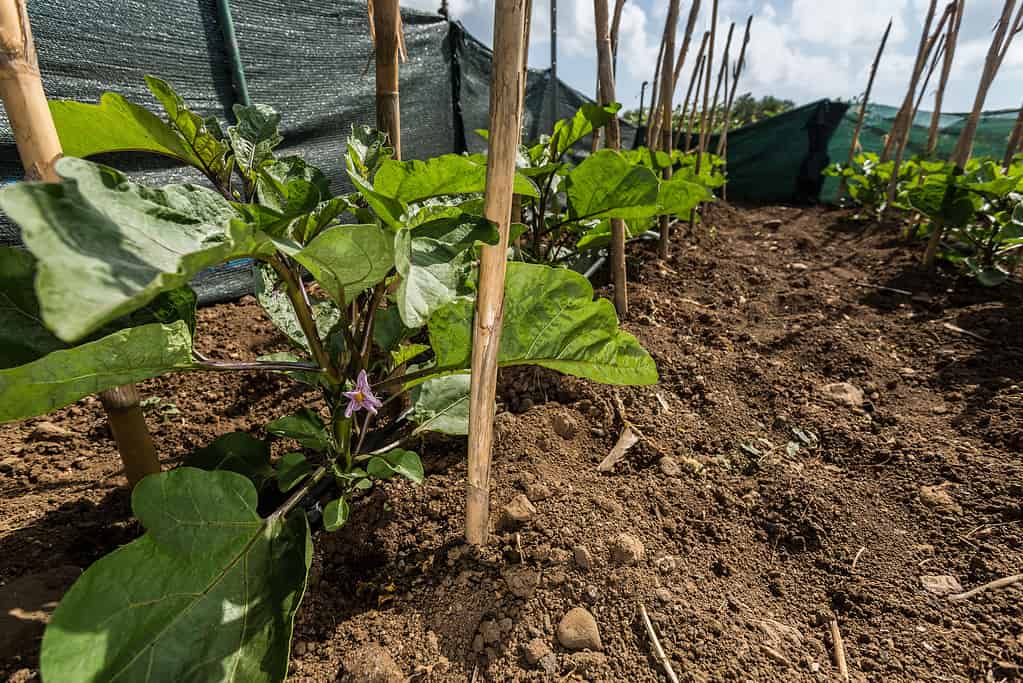
Eggplants take 100-150 days to reach maturity.
©Mathia Coco/Shutterstock.com
Minimizing or reducing most of the issues your eggplant will likely suffer from is possible. This can be achieved by practicing a few preventive measures that, include:
- Pre-warm the soil before transplanting your eggplant seedlings
- Encircle every eggplant seedling using a cutworm collar to prevent a cutworms attack
- Have the plants covered with floating covers when it gets too hot and also discourages flea beetles
- Weed around the plant roots carefully
- Always apply organic mulch whenever it gets too hot
When to Harvest
Eggplants take 100-150 days to grow from the seeds to full maturity. Only harvest the fruit when they become firm, full, and glossy. Please do not leave the eggplants to over-ripen, which makes them bitter.
To harvest, cut the eggplant’s stem using appropriate pruning shears. You can also use a sharp knife. Cut the stem at least 2 inches from the fruit attachment. Always put on a pair of gloves when you are harvesting to avoid being pricked by the thorns.
The photo featured at the top of this post is © iStock.com/Lari Bat
FAQs (Frequently Asked Questions)
How do you grow an eggplant step by step?
How do you grow eggplant for beginners?
How many months does it take for an eggplant to grow?
How often do you water eggplant?
Thank you for reading! Have some feedback for us? Contact the AZ Animals editorial team.






